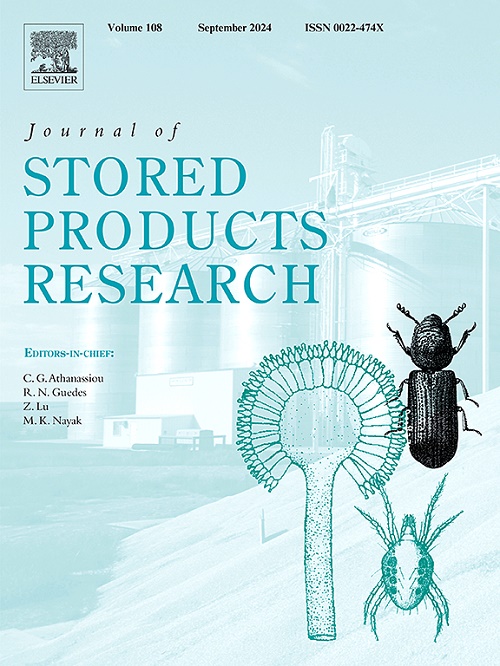Insecticidal effect of two Turkish entomopathogenic nematode isolates against Tribolium castaneum (Herbst) larvae and adults at different conditions
IF 2.7
2区 农林科学
Q1 ENTOMOLOGY
引用次数: 0
Abstract
Red flour beetle, Tribolium castaneum (Herbst.), is the most common pest of stored grains and products. Aerial and contact pesticides are used to control this pest. However, the red flour beetle has also developed significant resistance to phosphine, the main fumigant currently in use worldwide. The adverse effects of pesticides on non-target organisms, groundwater contamination, residues on food crops, and the emergence of insect resistance to chemicals have compelled the industry to prioritize the development of alternative control measures. Entomopathogenic nematodes find application in various agricultural systems. The insecticidal effect of two isolates of Steinernema feltiae Filipjev (Nematoda: Steinernematidae) and Heterorhabditis bacteriophora Poinar (Nematoda: Heterorhabditidae) against the different stages of T. castaneum. The entomopathogenic nematode isolates were examined at four concentrations (0, 250, 500, and 1000 IJs/ml) with a distilled water at 15 and 25 ± 1 °C temperatures. Results revealed that both S. feltiae (A-16) caused with 92.33% mortality rate while H. bacteriophora (O-7) caused with 76.77% mortality in the last instar larvae of the red flour beetle while these two species caused 75.38% and 66.85% mortality in adults, at 25 °C. The effect of nematodes decreased as the temperature decreased. According to results, the mortality rate of T. castaneum larvae treated with S. feltiae (A-16) with (54.62%) was significantly higher than that of H. bacteriophora (O-7) with (32.13%) 96 h after inoculation at 15 °C. The data indicated that 1000 IJs/ml was the most effective concentration of tested EPN isolates for all larval and adult stages.
In this study, our findings indicate that S. feltiae (A-16) and H. bacteriophora (O-7) can be used as effective biological control agents against both the larval and adult stages of the red flour beetle. The results demonstrate that EPNs are promising candidates for biocontrol of T. castaneum. This information is useful in designing future biological control programs.
土耳其两种昆虫病原线虫分离物在不同条件下对 Tribolium castaneum (Herbst) 幼虫和成虫的杀虫作用
红面粉甲(Tribolium castaneum (Herbst.))是储藏谷物和产品中最常见的害虫。空中和接触式杀虫剂被用来控制这种害虫。然而,红面粉甲虫也对磷化氢产生了明显的抗药性,而磷化氢是目前全球使用的主要熏蒸剂。杀虫剂对非目标生物的不利影响、地下水污染、粮食作物上的残留物以及昆虫对化学品抗药性的出现,迫使该行业优先发展替代控制措施。昆虫病原线虫在各种农业系统中都有应用。两种分离的 Steinernema feltiae Filipjev(线虫纲:Steinernematidae)和 Heterorhabditis bacteriophora Poinar(线虫纲:Heterorhabditidae)对不同阶段的 T. castaneum 的杀虫效果。昆虫病原线虫分离物在四种浓度(0、250、500 和 1000 IJs/ml)下与蒸馏水一起在 15 和 25 ± 1 °C 温度下进行检测。结果显示,在 25 °C 下,S. feltiae(A-16)和 H. bacteriophora(O-7)对红面粉甲虫末龄幼虫的致死率分别为 92.33% 和 76.77%,对成虫的致死率分别为 75.38% 和 66.85%。线虫的作用随着温度的降低而减弱。结果显示,在 15 °C 条件下,接种后 96 小时,用 S. feltiae(A-16)处理的 T. castaneum 幼虫死亡率(54.62%)明显高于用 H. bacteriophora(O-7)处理的幼虫死亡率(32.13%)。本研究结果表明,S. feltiae(A-16)和 H. bacteriophora(O-7)可作为有效的生物防治剂,用于防治红面粉甲虫的幼虫期和成虫期。研究结果表明,EPNs 是很有希望用于对红粉甲虫进行生物防治的候选生物。这些信息有助于设计未来的生物防治计划。
本文章由计算机程序翻译,如有差异,请以英文原文为准。
求助全文
约1分钟内获得全文
求助全文
来源期刊
CiteScore
5.70
自引率
18.50%
发文量
112
审稿时长
45 days
期刊介绍:
The Journal of Stored Products Research provides an international medium for the publication of both reviews and original results from laboratory and field studies on the preservation and safety of stored products, notably food stocks, covering storage-related problems from the producer through the supply chain to the consumer. Stored products are characterised by having relatively low moisture content and include raw and semi-processed foods, animal feedstuffs, and a range of other durable items, including materials such as clothing or museum artefacts.

 求助内容:
求助内容: 应助结果提醒方式:
应助结果提醒方式:


